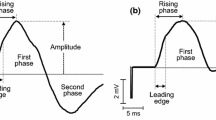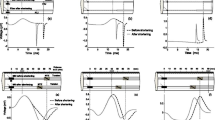Abstract
The similarity among surface electromyography (EMG) signals recorded by the poles of electrode arrays above deep muscles like erector spinae is a substantial obstacle in determining major muscle characteristics. What makes EMG signals so different when detected at various distances from the fibres? To answer this question, we simulated and analyzed extracellular potential fields produced by a single muscle fibre. We considered the fields at a few specific time instants. They corresponded to the origination of two depolarized zones at the end-plate, their propagation along both semi-fibres, and extinction at the fibre-ends. We used intracellular action potentials and muscle fibre propagation velocities typical for non-fatigued or fatigued muscle fibres. We have shown that at relatively small distances from the fibre, the strong potential fields are concentrated mainly near the sources. The interaction between potential fields is weak and the propagation of the fields and EMG signals in relatively long fibres is clearly apparent. At large distances, the potential fields are wide and the interaction between the fields produced by the two depolarized zones is strong. The total potential field could remain non-propagating during the entire main phase. As a result, the propagation will be obscured also in EMG signals.





Similar content being viewed by others
References
Arabadzhiev TI (submitted) Peculiarities of extracellular potentials produced by deep muscles. Part 2: motor unit potentials. Med Biol Eng Comput. doi:10.1007/s11517-013-1043-8
Arabadzhiev TI, Dimitrov GV, Chakarov VE, Dimitrov AG, Dimitrova NA (2008) Effects of changes in intracellular action potential on potentials recorded by single-fiber, macro, and belly-tendon electrodes. Muscle Nerve 37:700–712
Arabadzhiev TI, Dimitrov GV, Dimitrov AG, Chakarov VE, Dimitrova NA (2008) Factors affecting the turns analysis of the interference EMG signal. Biomed Signal Process Control 3:145–153
Dimitrov GV (1987) Changes in the extracellular potentials produced by unmyelinated nerve fibre resulting from alterations in the propagation velocity or the duration of the action potential. Electromyogr Clin Neurophysiol 27:243–249
Dimitrov GV, Dimitrova NA (1974) Extracellular potential field of an excitable fibre immersed in anisotropic volume conductor. Electromyogr Clin Neurophysiol 14:437–450
Dimitrov GV, Dimitrova NA (1998) Fundamentals of power spectra of extracellular potentials produced by a skeletal muscle fibre of finite length. Part I: effect of fibre anatomy. Med Eng Phys 20:580–587
Dimitrov GV, Dimitrova NA (1998) Precise and fast calculation of the motor unit potentials detected by a point and rectangular plate electrode. Med Eng Phys 20:374–381
Dimitrova N (1973) Influence of the length of the depolarized zone on the extracellular potential field of a single unmyelinated nerve fibre. Electromyogr Clin Neurophysiol 13:547–558
Dimitrova N (1974) Model of the extracellular potential field of a single striated muscle fibre. Electromyogr Clin Neurophysiol 14:53–66
Dimitrova NA, Dimitrov GV (2002) Amplitude-related characteristics of motor unit and M-wave potentials during fatigue. A simulation study using literature data on intracellular potential changes found in vitro. J Electromyogr Kinesiol 12:339–349
Dimitrova NA, Dimitrov GV (2003) Interpretation of EMG changes with fatigue: facts, pitfalls, and fallacies. J Electromyogr Kinesiol 13:13–36
Dimitrova NA, Dimitrov GV (2006) Electromyography (EMG) modeling. In: Metin A (ed) Wiley Encyclopedia of biomedical engineering. Wiley, Hoboken
Dimitrova NA, Dimitrov GV, Nikitin OA (2002) Neither high-pass filtering nor mathematical differentiation of the EMG signals can considerably reduce cross-talk. J Electromyogr Kinesiol 12:235–246
Farina D, Cescon C, Merletti R (2002) Influence of anatomical, physical, and detection-system parameters on surface EMG. Biol Cybern 86:445–456
Farina D, Gazzoni M, Merletti R (2003) Assessment of low back muscle fatigue by surface EMG signal analysis: methodological aspects. J Electromyogr Kinesiol 13:319–332
Farina D, Schulte E, Merletti R, Rau G, Disselhorst-Klug C (2003) Single motor unit analysis from spatially filtered surface electromyogram signals. Part I: spatial selectivity. Med Biol Eng Comput 41:330–337
Grassme R, Arnold D, Anders C, van Dijk JP, Stegeman DF, Linss W, Bradl I, Schumann NP, Scholle H (2005) Improved evaluation of back muscle SEMG characteristics by modelling. Pathophysiology 12:307–312
Gydikov A, Kosarov D (1972) Extraterritorial potential field of impulses from separate motor units in human muscles. Electromyogr Clin Neurophysiol 12:283–305
Hanson J, Persson A (1971) Changes in the action potential and contraction of isolated frog muscle after repetitive stimulation. Acta Physiol Scand 81:340–348
Inbar GF, Allin J, Kranz H (1987) Surface EMG spectral changes with muscle length. Med Biol Eng Comput 25:683–689
Lateva ZC, McGill KC, Burgar CG (1996) Anatomical and electrophysiological determinants of the human thenar compound muscle action potential. Muscle Nerve 19:1457–1468
Lindström L, Magnusson R, Petersen I (1970) Muscular fatigue and action potential conduction velocity changes studied with frequency analysis of EMG signals. Electromyography 10:341–356
Ludin HP (1973) Action potentials of normal and dystrophic human muscle fibers. In: Desmedt JE (ed) New development in electromyography and clinical neurophysiology. Karger, Basel, pp 400–406
Mannion AF, Dolan P (1996) The effects of muscle length and force output on the EMG power spectrum of the erector spinae. J Electromyogr Kinesiol 6:159–168
McGill KC, Lateva ZC, Xiao S (2001) A model of the muscle action potential for describing the leading edge, terminal wave, and slow afterwave. IEEE Trans Biomed Eng 48:1357–1365
Merletti R, Lo Conte L, Avignone E, Guglielminotti P (1999) Modeling of surface myoelectric signals—Part I: model implementation. IEEE Trans Biomed Eng 46:810–820
Rosenfalck P (1969) Intra- and extracellular potential fields of active nerve and muscle fibres. A physico-mathematical analysis of different models. Thromb Diath Haemorrh Suppl 321:1–168
Roy SH, De Luca CJ, Schneider J (1986) Effects of electrode location on myoelectric conduction velocity and median frequency estimates. J Appl Physiol 61:1510–1517
Shiraishi M, Masuda T, Sadoyama T, Okada M (1995) Innervation zones in the back muscles investigated by multichannel surface EMG. J Electromyogr Kinesiol 5:161–167
Wilson FN, Macleod AG, Barker PS (1933) The distribution of the action currents produced by heart muscle and other excitable tissues immersed in extensive conducting media. J Gen Physiol 16:423–456
Acknowledgments
This work was supported by the Bulgarian National Science Fund, grant DMU03/75. The author gratefully acknowledges Prof. Nonna Dimitrova and Prof. Roberto Merletti for their valuable comments on the manuscript.
Author information
Authors and Affiliations
Corresponding author
Electronic supplementary material
Below is the link to the electronic supplementary material.
Supplementary material 2 (MPG 45952 kb)
Supplementary material 3 (MPG 42057 kb)
Supplementary material 4 (MPG 66342 kb)
Supplementary material 5 (MPG 87485 kb)
Supplementary material 6 (MPG 110875 kb)
Supplementary material 7 (MPG 107564 kb)
Supplementary material 8 (MPG 48023 kb)
Supplementary material 9 (MPG 49373 kb)
Supplementary material 10 (MPG 55519 kb)
Rights and permissions
About this article
Cite this article
Arabadzhiev, T.I. Peculiarities of extracellular potentials produced by deep muscles. Part 1: single fibre potential fields. Med Biol Eng Comput 51, 677–686 (2013). https://doi.org/10.1007/s11517-013-1037-6
Received:
Accepted:
Published:
Issue Date:
DOI: https://doi.org/10.1007/s11517-013-1037-6




